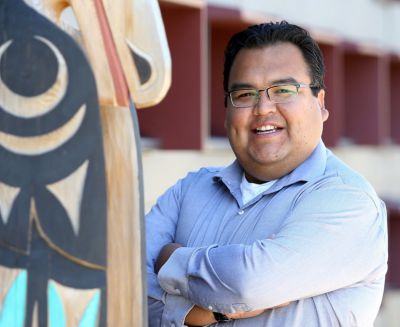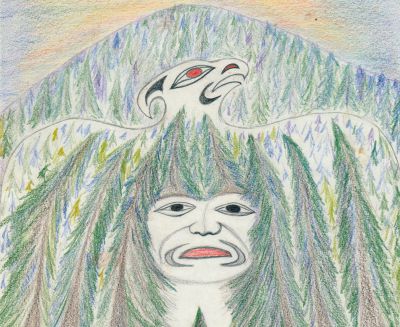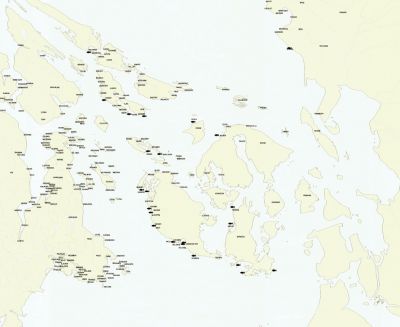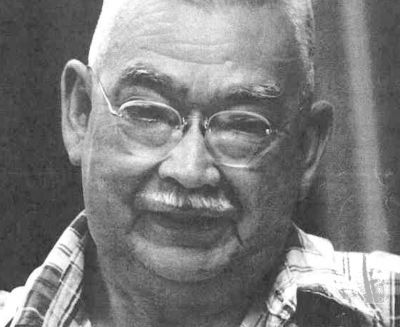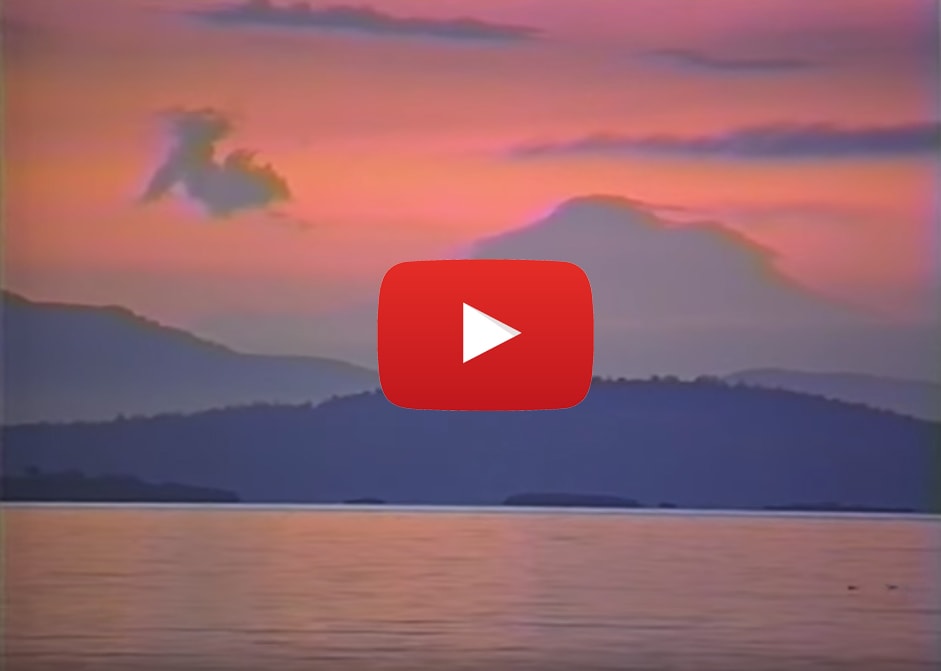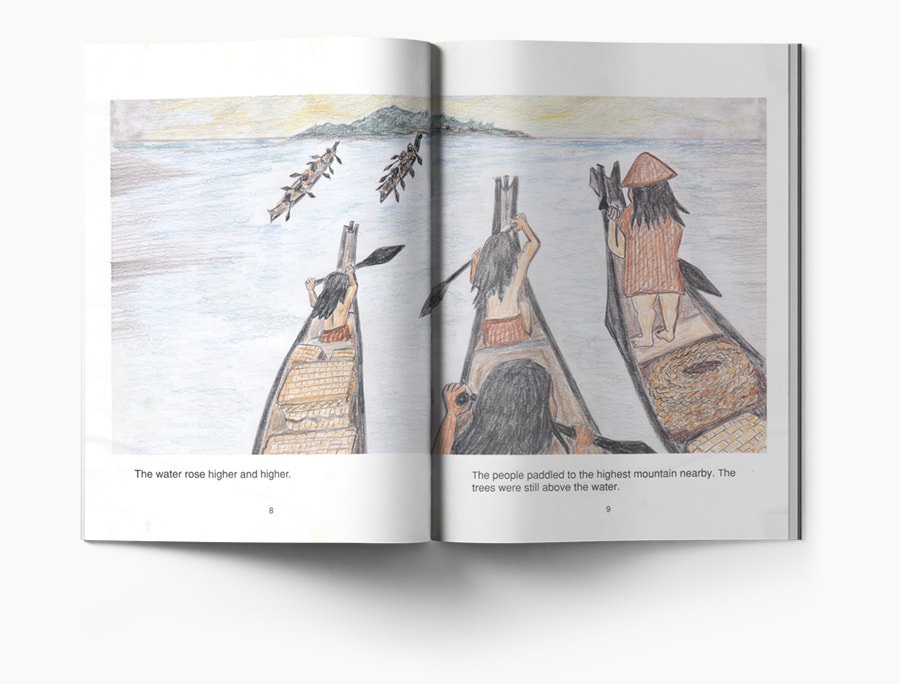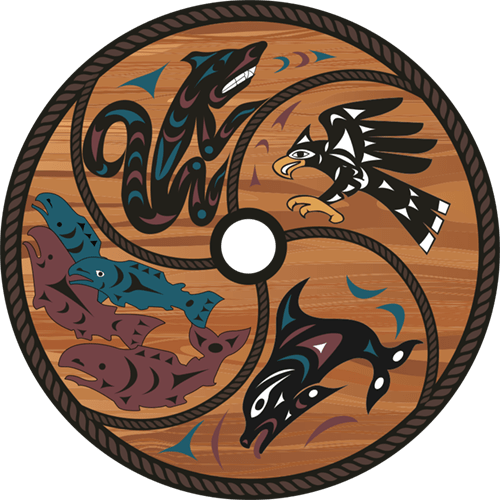Chairman’s Message
A message from the Chairman of the Board: Chief Don Tom, Tsartlip First Nation
ÍY SȻÁĆEL HÁLE
I take pride in announcing and providing background on the establishment of the W̱SÁNEĆ Leadership Council Society, incorporated under the Societies Act on May 7, 2018.
WLC is comprised of two W̱SÁNEĆ First Nations: Tsartlip & Tseycum. After many years and continued discussions amongst W̱SÁNEĆ Chiefs regarding infringement and breaches of Douglas Treaty within our territory, it was evident that the formalization of a unified body to represent W̱SÁNEĆ common interests was necessary. Previous to the establishment of the W̱SÁNEĆ Leadership Council, proponents, corporations and governments were able to take advantage of the fact that the W̱SÁNEĆ Bands were divided, and, as our elders have said, “when we disagree, the government wins.” By standing together, the W̱SÁNEĆ Leadership Council will be a reckoning force within our Territory.
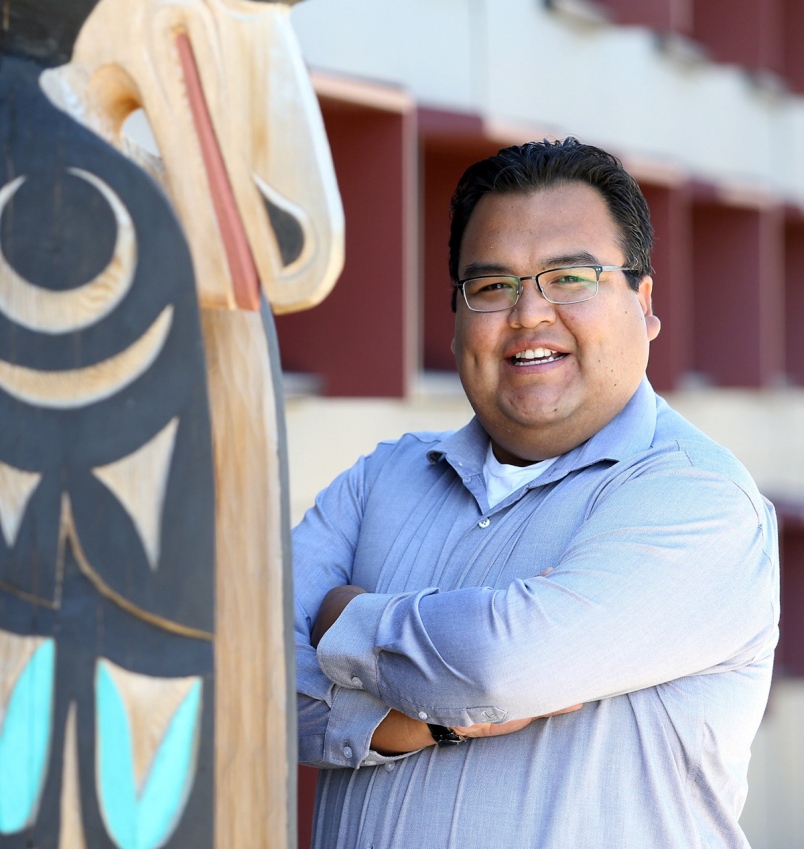
W̱SÁNEĆ Leadership Council Chairman – Chief Don Tom (Tsartlip First Nation)
In January 2018, the WLC submitted a 3-month Work Plan and Budget Proposal to the Federal Government for funding to support discussions related to the W̱SÁNEĆ Bands establishing a unified legal governing body. The proposal was approved, and after 3 months of discussion and deliberation it was decided that the W̱SÁNEĆ bands would proceed with the formalization of a unified legal entity called the W̱SÁNEĆ Leadership Council (WLC). Furthermore, it was decided that the WLC would enter into exploratory discussions with the Federal Government through the Recognition of Indigenous Rights & Self Determination (RIRSD) program. The goal of the RIRSD program is to bring greater flexibility to discussions between First Nations and the Federal Government based on the recognition of rights, respect, cooperation and partnership. At these discussions, W̱SÁNEĆ can explore with Canada new ideas and ways to reach agreements that will recognize our rights and advance our vision of self-determination. In March 2018, a subsequent 2018-2019 Budget and Workplan Proposal was submitted on behalf of WLC to the Federal Government and was once again approved for funding.
In August 2018, the WLC rented and renovated the old Tsartlip Health Building to utilize as its headquarters and main office.
September 2018, WLC submitted a proposal to the Federal Government’s “Nation Rebuilding” funding program. The Nation Rebuilding program is aimed at providing funding to help bands reconstitute themselves as nations once again. WLC submitted a series of “Unity Projects” and as a result the submission was approved. As a first step, we are excited to announce the “Travelling Together Project” and the “W̱SÁNEĆ Song Restoration Project.”
The Travelling Together Project will see the WLC coordinate and administer funding to construct four sibling ocean travel canoes, one for each of the 4 W̱SÁNEĆ villages. These canoes will participate annually in Tribal Journeys, will be used to reef net fish, and will be involved in ceremonies. Once again W̱SÁNEĆ will travel and work in unity on the water.
The W̱SÁNEĆ Song Restoration Project is a project to restore W̱SÁNEĆ traditional social and public protocol songs. W̱SÁNEĆ had songs of prayer, paddle songs, dinner songs, victory songs, etc., but, unfortunately, these have been eroded over time by colonialism. Singers from each of the four W̱SÁNEĆ villages are currently coming together to share and restore W̱SÁNEĆ songs so that we may stand strong once again with a united voice.
On January 24, 2019 the W̱SÁNEĆ Leadership Council and Canada signed a Letter of Understanding committing both parties to move forward together to advance lasting reconciliation and make real progress on the issues most important to the W̱SÁNEĆ Nation. Through the Letter of Understanding, Canada and W̱SÁNEĆ Nation will explore a number of priorities that would support the eventual negotiation of a nation-to-nation reconciliation agreement. Priority topics include: Gulf Island National Park Reserve; the recognition and implementation of Douglas Treaty rights; Fisheries; acquisition of lands; and education. The Letter of Understanding marks an important shift in the W̱SÁNEĆ people’s relationship with the Federal Government. We have waited for over 150 years to have productive conversations with the Federal Government aimed at solving the long-standing issues that impact the lives and livelihoods of our people. We look forward to further developing this relationship and envisioning, together, a more hopeful future for the W̱SÁNEĆ people.
Other work and discussion tables include:
- Negotiating Government-to-Government relationship with the Capital Regional District (CRD) and discussing the Residuals Treatment Facility at Hartland Landfill
- The feasibility of the Proposed National Marine Conservation Area in the Southern Strait of Georgia
- Changing the relationship that the W̱SÁNEĆ Leadership Council has with Parks Canada and the Gulf Island National Park Reserve
- Ensuring that the W̱SÁNEĆ Leadership Council and the Victoria Airport Authority can work toward an agreement that will benefit the W̱SÁNEĆ community
- Developing a W̱SÁNEĆ Leadership Council Economic Development Corporation
- Discussing the potential impacts of the Joint Utilities Board Sewage Outfall Project with the District of North Cowichan
The Legend of ȽÁU, WELṈEW̱
In the beginning it was the W̱SÁNEĆ teaching to look after Mother Earth. All of the animals, the birds, the trees and the salmon, even the wind, were, and still are, people.
For many years the people remembered the words of the creator (XÁLS) and there was a long period of happiness and plentiful food. Then they began to forget those teachings.
The creator’s feelings were hurt that the people began to forget his good teachings, so the creator told the people that a great flood would come and said: “You prepare yourselves.”
The people prepared a cedar rope and gathered their food and all of their possessions. The tide waters began to rise. The people loaded all of their belongings into their canoes.
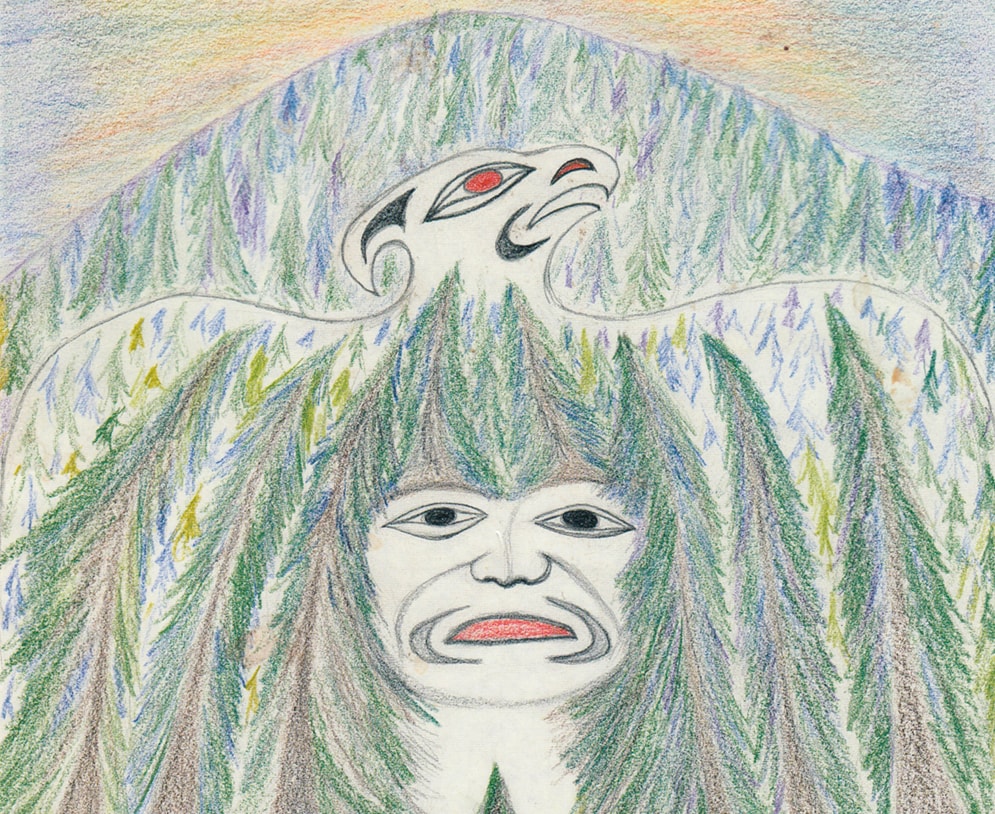
Illustration by STOLȻEȽ (John Elliott).
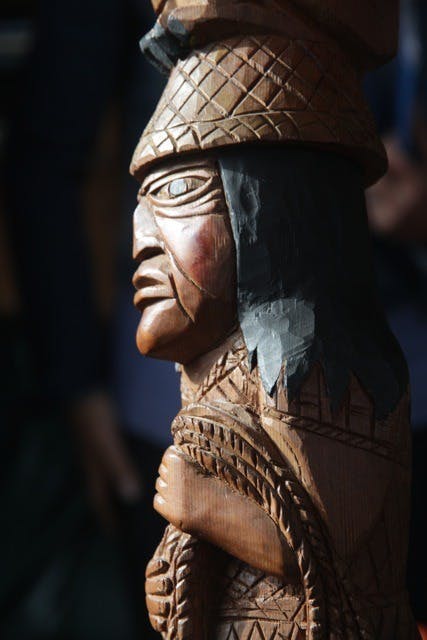
W̱SÁNEĆ Carving by STOLȻEȽ (John Elliott) depicting a Reef Net Captain carrying cedar rope.
Some people did not heed XÁLS teachings. They were not prepared and were washed away. Their canoes were destroyed.
The water rose higher and higher. The people paddled to the highest mountain nearby. The trees were still above the water. They tied themselves to an arbutus tree on top of the mountain.
Soon the tops of the trees were covered with water. They were afraid and prayed to survive the great flood. They asked XÁLS to take pity on them.
After many days, a crow came and landed on the bow of the canoe. He was carrying a stick and was talking to the people. The crow had brought the good news.
Suddenly a mountain began to emerge in the distance. One of the men said, “NI QENNET TTE W̱SÁNEĆ”, (translated means, “Look at what is emerging”), as he pointed to the mountain emerging in the distance.
Before they left the mountain, they gathered around the huge coil of cedar rope and gave thanks. They said from now on this mountain will be called LÁU,WELNEW (Place of refuge). They also said, “We will be called the W̱SÁNEĆ” (The emerging people).
XÁLS heard their prayers. XÁLS said he would not punish the people by flood again. The people who were saved are the ancestors of the W̱SÁNEĆ Tribe today.
This is our heritage.
Á,LEṈENEȻ ȽTE – OUR HOMELAND
The W̱SÁNEĆ People are Salt Water People. The Sea was very important to our way of life. Traditionally the W̱SÁNEĆ People had homes throughout the San Juan Islands and on the east and north coasts of the Saanich Peninsula.
Our land went east through the Gulf Islands and San Juan Islands and northeast across Georgia Strait to Boundary Bay. Our territory included the Saanich Inlet and deep into the forest lands on its west side. On the Saanich Peninsula itself, our land went south as far as PKOLS (Mount Douglas), and from there across to W̱QENNELEȽ (Mt. Finlayson) and SELE₭TEȽ (Goldstream).
W̱SÁNEĆ (Saanich Peninsula) was the headquarters because this is where the W̱SÁNEĆ People built their permanent winter homes.
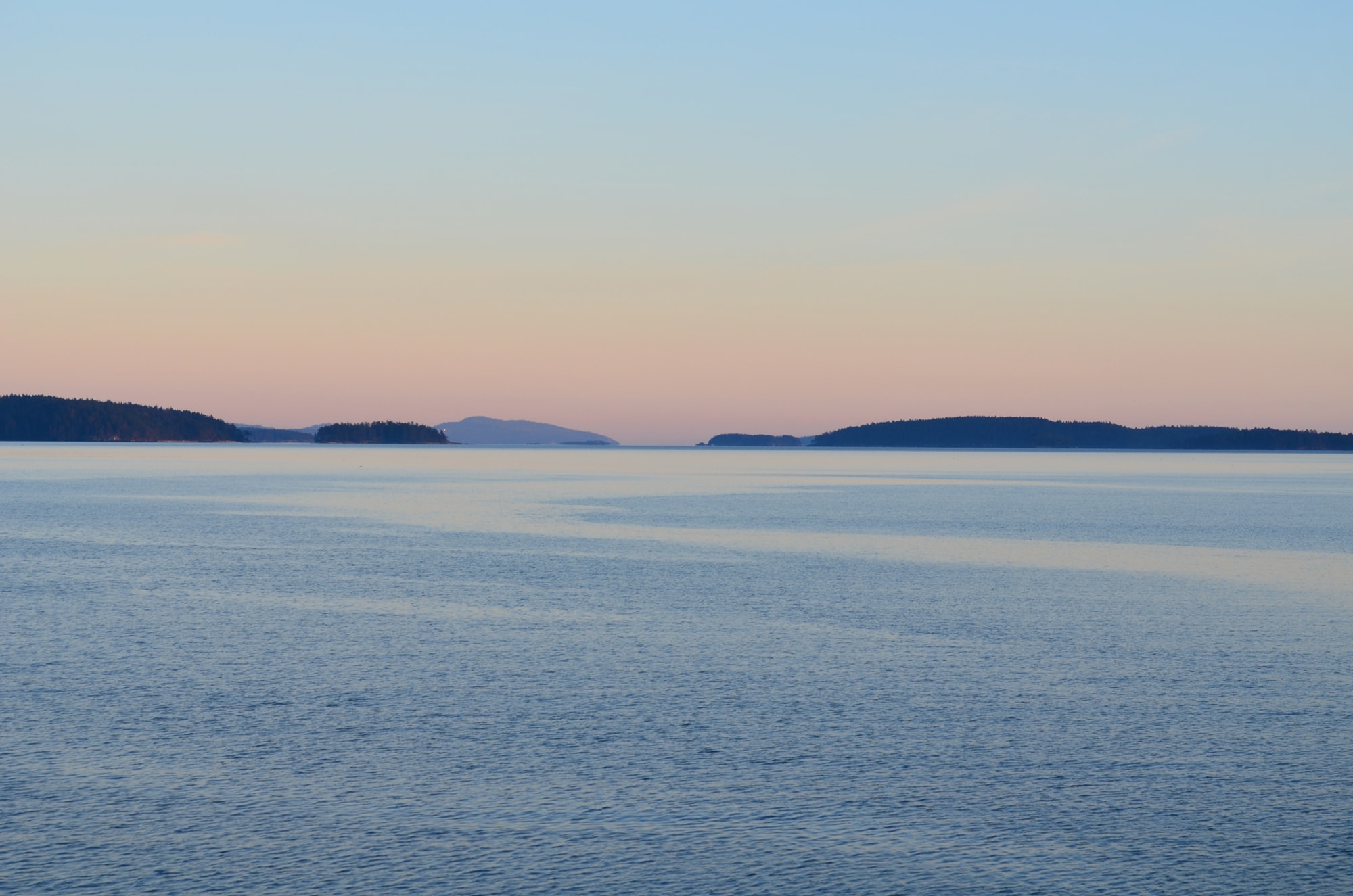
Drag the square below, or click the map to explore the place names.
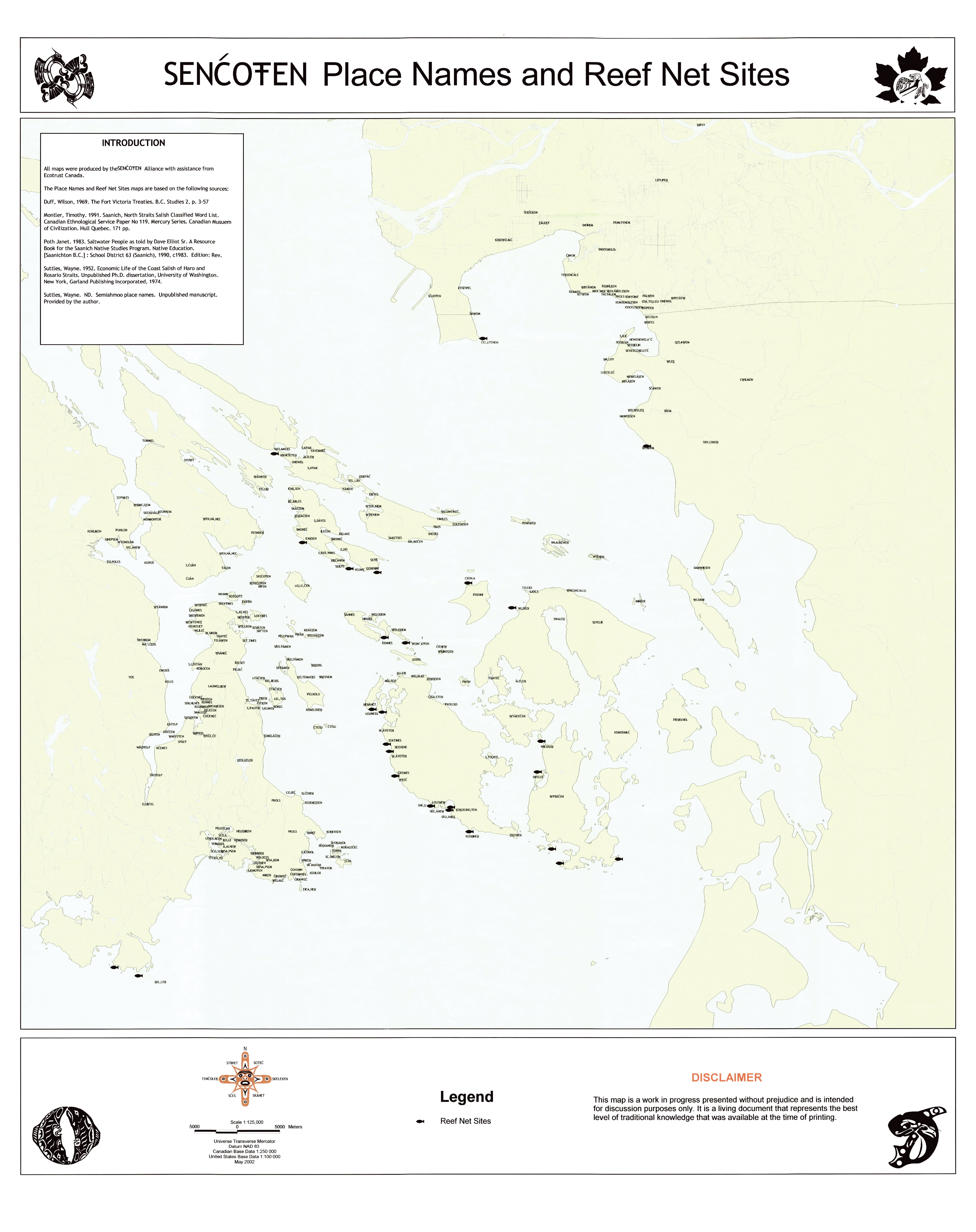
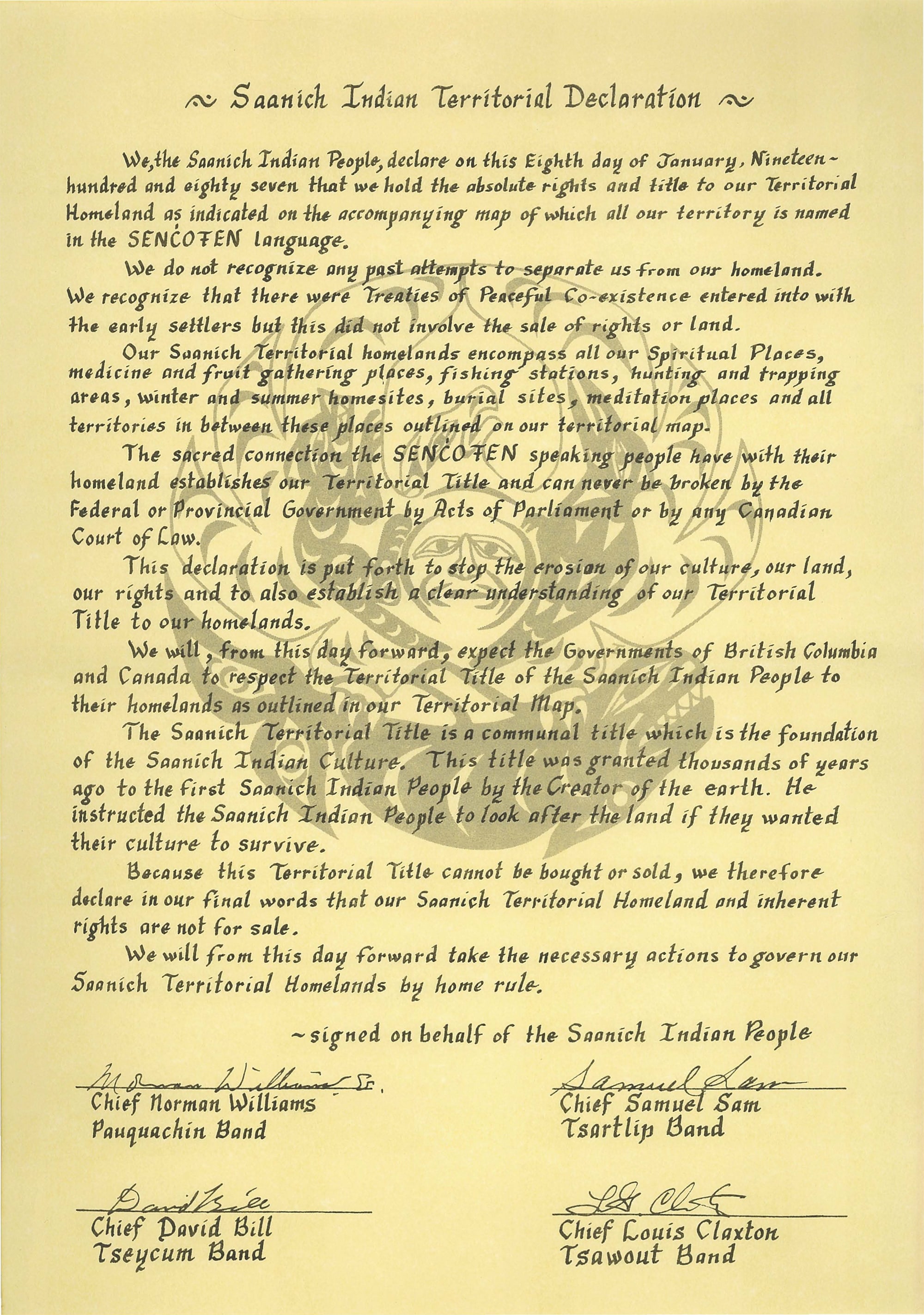
W̱SÁNEĆ Culture
Our people lived as part of everything. We were so much a part of nature, we were just like the birds, the animals, the fish. We were like the mountains. Our people lived that way. We knew there was an intelligence, a strength, a power, far beyond ourselves. We knew that everything here didn’t just happen by accident. We believed there was a reason for it being here. There was a force, a strength, a power somewhere that was responsible for it. That is the way our people lived. They lived according to that belief, according to that knowledge. The universe lies before you…”
-David Elliott Sr. (Saltwater People, School District 63 (Saanich, 1990))
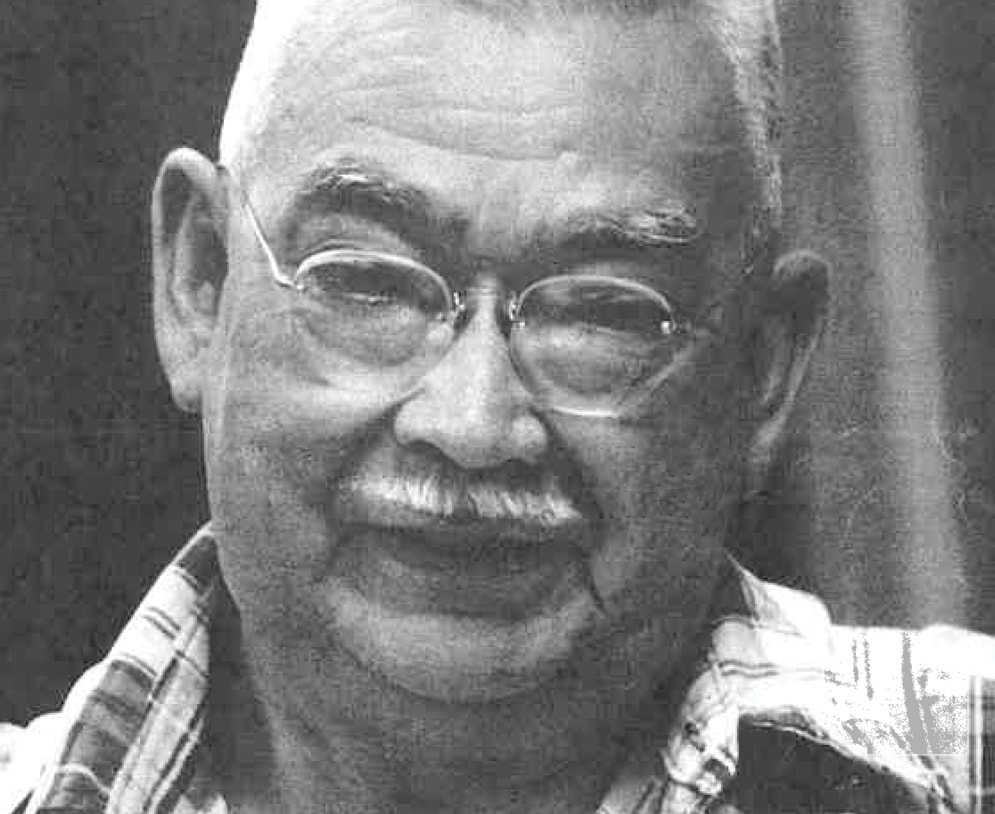
The late David Elliott Sr.
SENĆOŦEN Language
SENĆOŦEN is the language of the W̱SÁNEĆ people. SENĆOŦEN is a member of a dialect continuum called Northern Straits which is a Coast Salishan language.
The SENĆOŦEN alphabet was devised by the late Dave Elliott. Dave was born on the Tsartlip reserve in June 1910. Like many Saanich families of the day, he fished and traveled over the historical homeland of the Saanich. His family knew all of the places by their original SENĆOŦEN names. Dave once said, “I saw how our old people lived before our own speaking system was broken down. Our people were the wealthiest on earth. We needed nothing. We lived in a virtual paradise”.
Then came regulations forbidding the Saanich People from fishing, hunting and food gathering over their traditional lands. Government policies of the day dictated that the families who were struggling to survive had their children taken away to residential schools. There, the Saanich children began to experience denial of the SENĆOŦEN language and culture. Over the years, this created a communication gap between those who were still at home speaking SENĆOŦEN and those who had begun to be educated and assimilated into the white education system.
In the early 1960’s, Dave Elliott became a custodian at the Tsartlip Indian Day School, attended by most of the Saanich children. Dave recognized the rapid decline in the use of SENĆOŦEN and the knowledge of the language and culture. The late Phillip Paul led an initiative to establish the Saanich Indian School Board. The SENĆOŦEN language was immediately offered as part of the curriculum of the band operated school.
Realizing that without a method of recording the language it would eventually be lost, Dave began to write down SENĆOŦEN words phonetically. He soon discovered that upon returning to read previously recorded words, he could not understand what he had written. Dave studied with a Victoria linguist, learning the International alphabet and other orthographies. The main difficulty with these systems was that some of the complex sounds of the SENĆOŦEN language required numerous symbols to be represented, resulting in long and complicated words.
Dave decided to devise his own alphabet, using only one letter to denote each sound. He purchased a used typewriter for $30 and set out to make the SENĆOŦEN writing system accessible to his people. During the winter of 1978 the Dave Elliott SENĆOŦEN Alphabet was created. In 1984 the Saanich Indian School Board adopted the Dave Elliott Alphabet to help preserve the SENĆOŦEN language and history.
Dave Elliott’s legacy is the revitalization of the SENĆOŦEN language. Today, Apple iMac computers with a TrueType SENĆOŦEN font are used extensively in the teaching of the language, both at ȽÁU, WELṈEW̱ Tribal School, and throughout the surrounding public schools of Saanich SD 63.
The B.C. Ministry of Education is advocating similar uses of technology elsewhere in the province as valuable tools in the task of revitalizing indigenous languages before it is too late.


